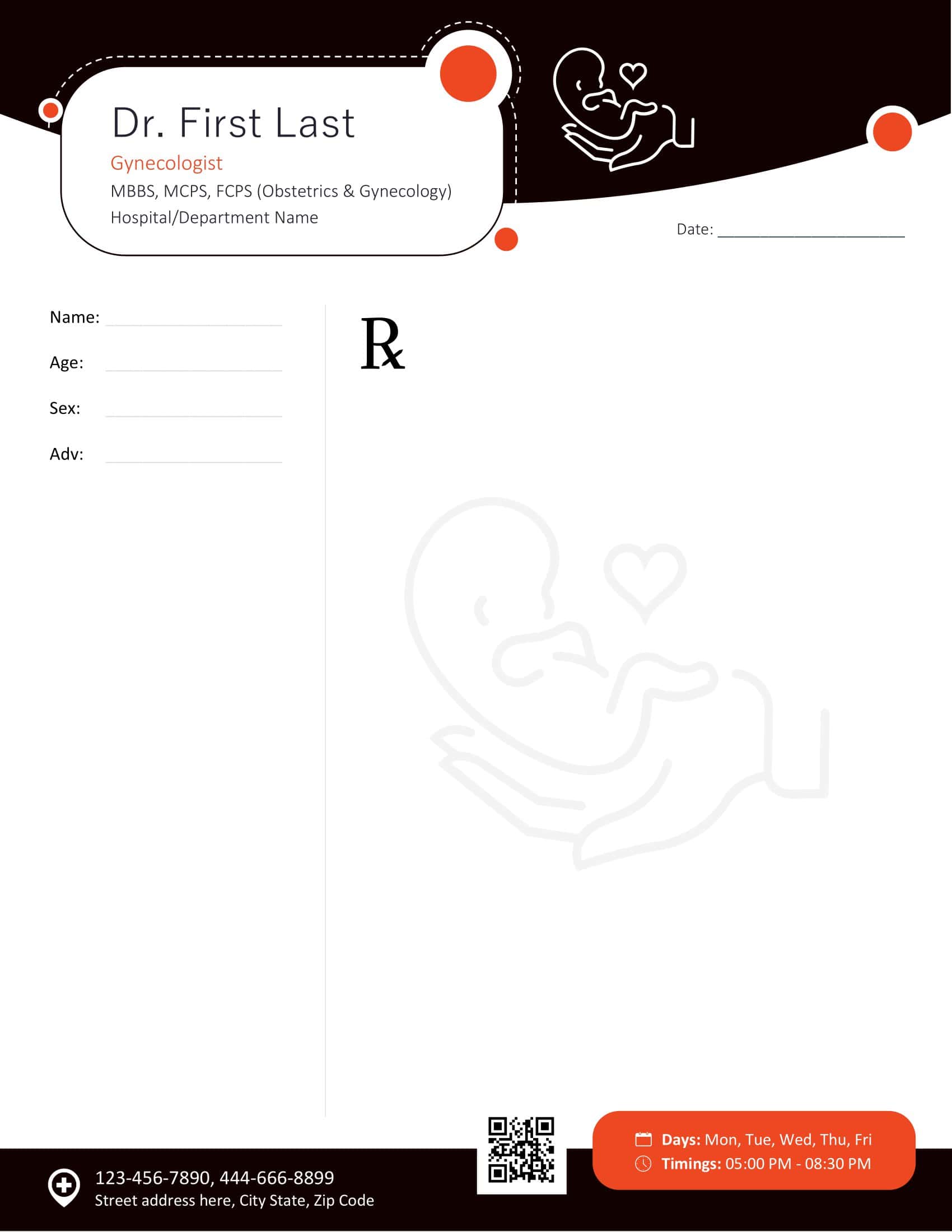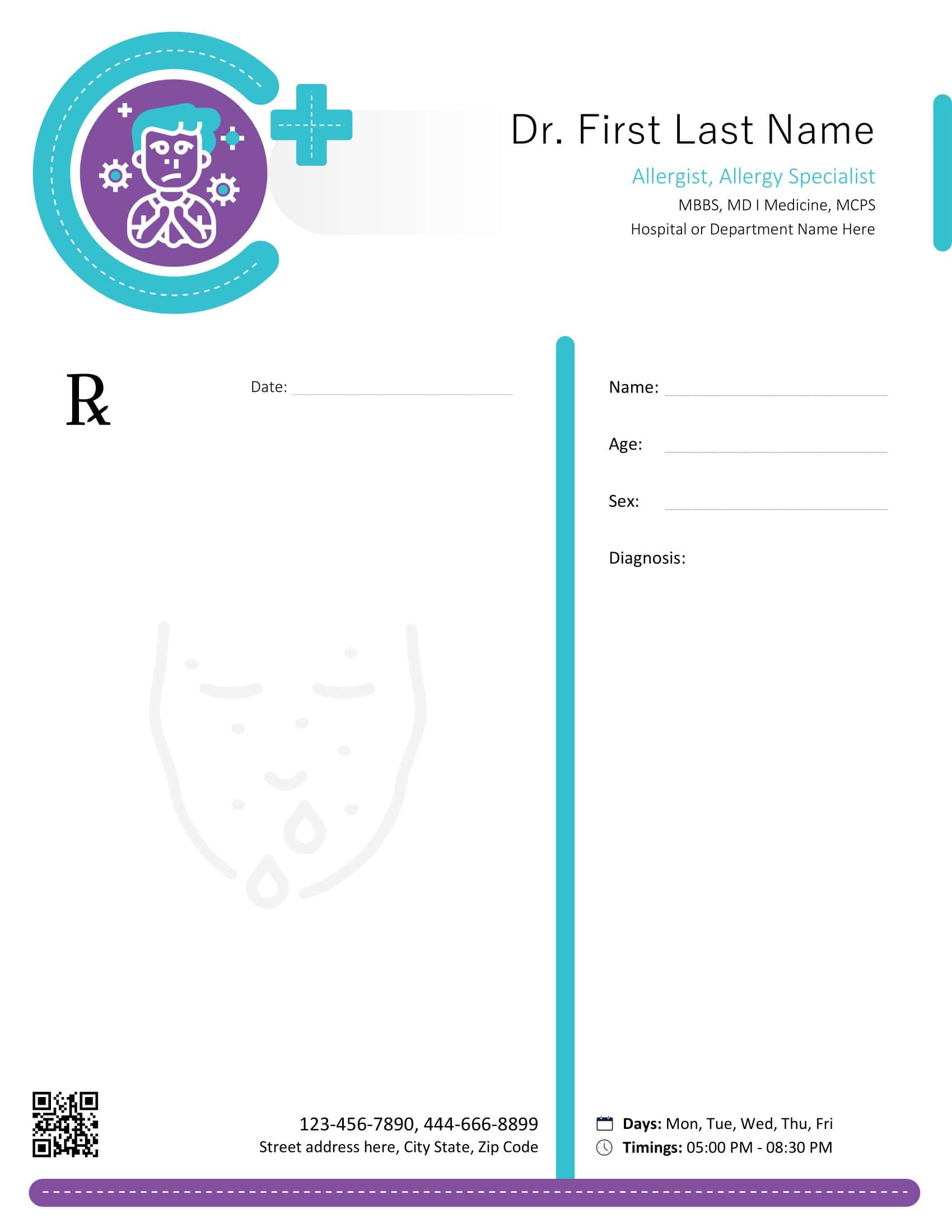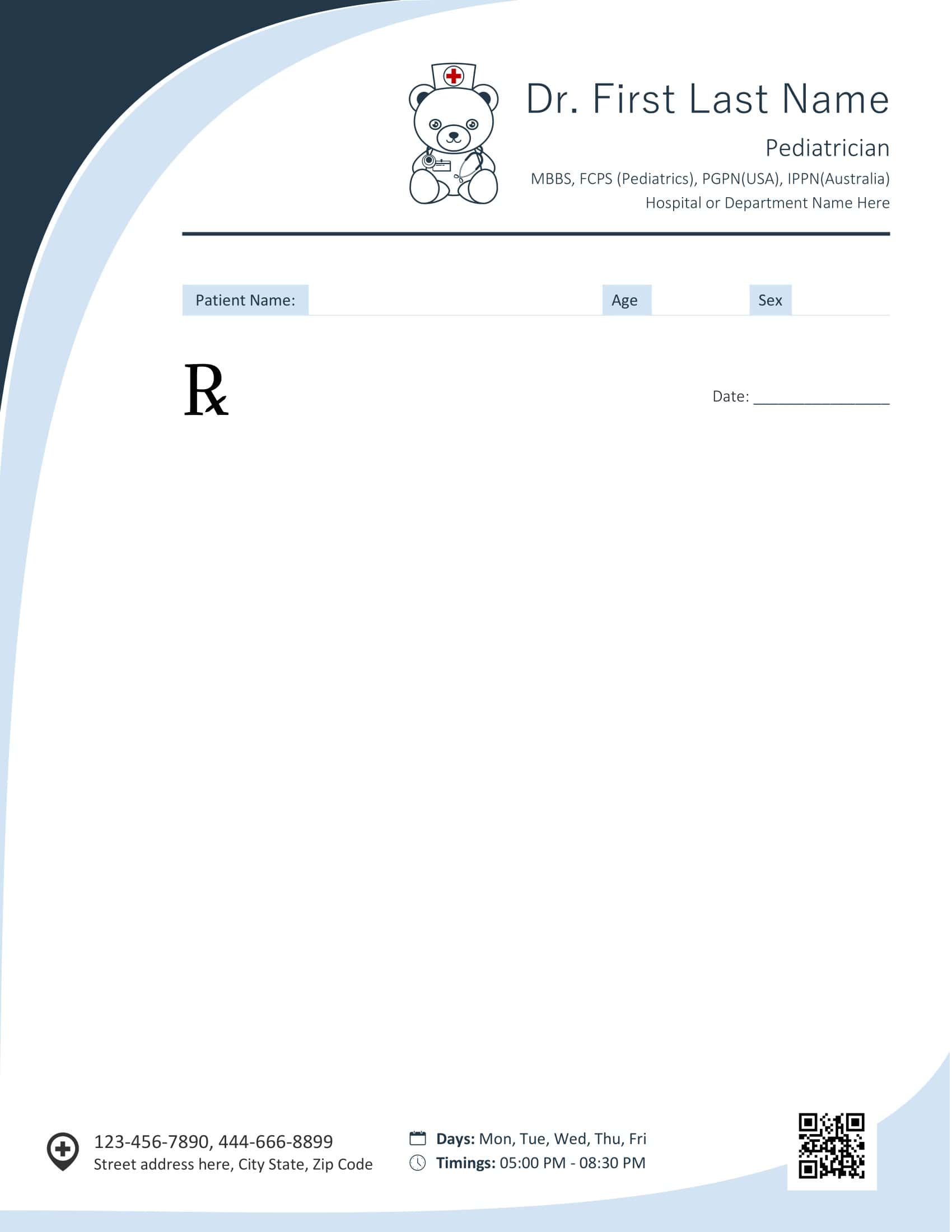Prescriptions play a crucial role in healthcare, serving as a written instruction from a healthcare provider to a pharmacist regarding the medication and dosage that a patient requires. To ensure accuracy and efficiency in prescribing medications, healthcare professionals often utilize prescription templates. These templates provide a standardized format for creating prescriptions, simplifying the process and minimizing errors.
Table of Contents
What Is a Prescription Template?

What is a prescription template, and why is it important? A prescription template is a pre-designed document that outlines the necessary information required for a prescription. It serves as a framework for healthcare professionals to fill in the specific details, such as the patient’s name, medication, dosage, and instructions.
The importance of a well-structured prescription template cannot be overstated. It helps to maintain consistency, ensuring that all necessary information is included and eliminating the risk of vital details being overlooked. Additionally, it helps to enhance efficiency by reducing the time required to create each prescription from scratch.
Prescription Templates
A well-structured prescription template plays a pivotal role in maintaining patient safety. By providing a standardized format, it ensures that healthcare professionals adhere to best practices when prescribing medications. This includes including vital information such as the drug name, dosage, frequency, route of administration, and any additional instructions.
Besides ensuring patient safety, a well-structured template also promotes effective communication between healthcare providers and pharmacists. By utilizing a consistent format, healthcare professionals can convey their intentions clearly, reducing the likelihood of misinterpretation or errors during the dispensing process.
Moreover, a well-structured prescription template can also contribute to improved patient outcomes. With all the necessary information clearly outlined, pharmacists can accurately dispense the prescribed medication, reducing the risk of medication errors. This is particularly crucial when dealing with complex medication regimens or patients with multiple prescriptions.
Key Elements of a Prescription Template
When designing a prescription template, it is crucial to include key elements that will provide all the necessary information and enhance prescription accuracy. These elements may include:
- Patient Information: The template should include spaces or fields to input the patient’s name, date of birth, and contact information. This ensures that each prescription is specific to the individual patient.
- Medication Details: The template should provide sections to input the medication name, strength, and dosage form. Additionally, it should include spaces for specifying the dosage instructions, such as frequency and duration of use.
- Prescribing Healthcare Professional: The template should include a section for the prescribing healthcare professional to provide their name, credentials, and contact information. This ensures that the pharmacist can easily reach out for clarification if needed.
- Medical Conditions and Allergies: Including a section for medical conditions and allergies can help healthcare professionals make informed decisions when prescribing medications. It allows them to consider potential contraindications or drug interactions that may affect the patient’s safety and well-being.
- Signature and Date: A prescription template should have a designated space for the prescribing healthcare professional to sign and date the prescription. This adds an extra layer of accountability and ensures that the prescription is valid and up-to-date.
By incorporating these key elements into a prescription template, healthcare professionals can streamline the prescribing process, improve patient safety, and enhance overall communication and collaboration within the healthcare team.
Steps to Designing an Effective Prescription Template

Designing an effective prescription template involves careful consideration of various factors such as software selection, layout, design, and the inclusion of essential information fields. Let’s explore these steps in detail:
Choosing the Right Software for Template Creation
The first step is to select appropriate software for creating your prescription template. Ensure that the chosen software provides flexibility in designing templates and offers the ability to customize fields and layouts according to your specific needs. Several software options provide ready-to-use, customizable prescription templates that can be tailored to suit your practice.
When choosing software, it’s important to consider factors such as user-friendliness, compatibility with your existing systems, and the availability of technical support. Look for software that allows you to easily update and modify your prescription templates as needed, ensuring that you can adapt to any changes in medical guidelines or regulations.
Layout and Design Considerations
The layout and design of your prescription template significantly impact its usability and readability. Some essential considerations include:
- Simplify the Layout: Avoid overcrowding the template with excessive information. A clean and uncluttered layout enhances legibility and reduces the risk of errors.
- Clear Section Divisions: Use visual cues such as lines or headings to divide different sections of the prescription. This helps healthcare providers and pharmacists easily locate and understand the different elements of the prescription.
- Font and Font Size: Use legible fonts and an appropriate font size to ensure clear readability. Avoid using overly decorative or complex fonts that may hinder comprehension.
Additionally, consider the overall aesthetic appeal of your prescription template. While functionality is key, a visually pleasing design can also contribute to a positive patient experience. Incorporating your practice’s branding elements, such as logo and color scheme, can help create a cohesive and professional look.
Incorporating Essential Information Fields
To ensure comprehensive prescription templates, it is essential to incorporate specific fields for key information. These may include:
- Date of Prescription: A field for the healthcare provider to indicate the date the prescription was written.
- Diagnosis: A section for noting the patient’s diagnosis or medical condition, providing context for the prescribed medication.
- Drug Allergies: An area to highlight any documented drug allergies or intolerances the patient may have.
Furthermore, consider including fields for the patient’s demographic information, such as name, age, and contact details, as well as the prescriber’s information, including name, credentials, and contact information. These additional fields ensure that all relevant information is readily available and help facilitate effective communication between healthcare providers, pharmacists, and patients.
Legal and Ethical Considerations in Prescription Template Design
Prescription templates must adhere to legal and ethical standards to ensure patient safety and confidentiality. Here are some critical considerations:
Confidentiality and Data Protection
Prescription templates should emphasize patient confidentiality and include measures to protect sensitive patient information. Ensure that the templates are securely stored and accessible only to authorized healthcare providers.
When designing prescription templates, it is crucial to consider the various ways in which patient data can be protected. Implementing encryption techniques and secure storage systems can help safeguard patient information from unauthorized access. Additionally, healthcare providers should be educated on the importance of maintaining confidentiality and the potential consequences of breaching patient privacy.
Furthermore, it is essential to regularly update and review the security measures in place to ensure they align with the latest industry standards. This includes staying informed about emerging threats and implementing necessary changes to mitigate risks.
Legal Requirements for Prescription Template
Familiarize yourself with your jurisdiction’s legal requirements for prescription templates. Certain jurisdictions may have specific guidelines, including font size for controlled substance prescriptions, mandatory inclusion of the healthcare provider’s Drug Enforcement Administration (DEA) number, or requirements for electronic prescriptions.
Compliance with legal requirements is paramount when designing prescription templates. Failure to adhere to these regulations can result in severe consequences, including legal penalties and potential harm to patients. Therefore, it is essential to stay updated on any changes in the legal landscape and ensure that prescription templates are regularly reviewed and modified to remain in compliance.
Moreover, it is crucial to consider the unique requirements of different jurisdictions. Each region may have its own set of regulations and guidelines that must be followed. By understanding and incorporating these specific requirements into prescription template design, healthcare providers can ensure that their practices align with the law and maintain the highest standards of patient care.
Tips for Making Your Prescription Template User-Friendly
Making your prescription template user-friendly not only benefits healthcare providers but also ensures a positive experience for patients and pharmacists. Consider the following tips:
Simplifying the Layout
Avoid complicating the template layout by including irrelevant information or excessive details. A clean and concise layout facilitates quick and accurate prescription completion.
Using Clear and Legible Fonts
The choice of fonts significantly impacts the readability of the prescription template. Select clear, easily readable fonts such as Arial or Times New Roman. Additionally, ensure an appropriate font size for optimal legibility.
Furthermore, it is essential to consider the spacing between the lines and paragraphs in your prescription template. Adequate spacing not only enhances readability but also allows healthcare providers to make necessary annotations or modifications without causing confusion.
Another aspect to keep in mind is the use of color in your template. While it may be tempting to add vibrant colors to make the prescription visually appealing, it is crucial to strike a balance. Opt for a color scheme that is easy on the eyes and does not distract from the important information contained within the prescription.
Moreover, including a section for additional notes or instructions can greatly improve the user-friendliness of your prescription template. This section allows healthcare providers to provide specific guidance or precautions to patients and pharmacists, ensuring that the medication is used correctly and safely.
Maintaining and Updating Your Prescription Template
Prescription practices and regulations may evolve over time. To ensure efficacy and compliance, it is important to regularly review and update your prescription template. Consider the following:
Regular Review and Updates
Periodically review your prescription template to ensure it aligns with the latest best practices and regulatory requirements. Update the template to include any new fields or information necessary for accurate and comprehensive prescribing.
Adapting to Changes in Prescription Practices
Stay informed about changes in prescription practices, such as the incorporation of electronic prescribing or changes in controlled substance regulations. Adapt your template accordingly to ensure compliance with evolving standards and regulations.
But what exactly should you be looking for when reviewing and updating your prescription template? Let’s delve into some key areas that you should consider:
1. Patient Information
Make sure that your prescription template includes all the necessary patient information, such as name, date of birth, and contact details. Additionally, consider including any relevant medical history or allergies to help prevent adverse reactions.
2. Medication Details
Ensure that your template includes fields for capturing the medication details accurately. This should include the drug name, dosage, frequency, and duration of treatment. It is also important to include clear instructions for use to avoid any confusion for the patient.
As prescription practices continue to evolve, it is crucial to stay up-to-date with the latest advancements and changes. One area that has seen significant progress is electronic prescribing. With the increasing adoption of electronic health records, many healthcare providers are transitioning from traditional paper prescriptions to electronic prescriptions.
Electronic prescribing offers numerous benefits, including improved accuracy, efficiency, and patient safety. It allows healthcare professionals to electronically send prescriptions directly to pharmacies, reducing the risk of errors that can occur with handwritten prescriptions. Additionally, electronic prescribing systems often include built-in safety checks, such as drug interaction alerts, to help prevent medication errors.
Another important aspect to consider when updating your prescription template is changes in controlled substance regulations. These regulations are put in place to prevent the misuse and abuse of certain medications. Staying informed about any updates or changes in these regulations is crucial to ensure compliance and patient safety.
By regularly reviewing and updating your prescription template, you can ensure that it remains current and aligned with the latest best practices and regulatory requirements. This not only helps optimize medication management but also enhances patient safety and improves overall healthcare outcomes.
FAQs
Why is the accuracy of a prescription template important?
Accuracy is critical to ensure patient safety. An incorrect or unclear prescription can lead to medication errors, adverse reactions, or ineffective treatment. Properly filled templates reduce the risk of misinterpretation and ensure the patient receives the correct medication and dosage.
How long is a prescription valid?
The validity of a prescription can vary based on local regulations, the type of medication prescribed, and the specific condition being treated. Generally, many prescriptions expire after one year, but controlled substances might have shorter validities.
Can a pharmacist change a prescription?
A pharmacist may not change the drug or dose on a prescription without consulting and receiving authorization from the prescribing healthcare provider. However, they might substitute a generic equivalent if the prescription doesn’t have a “Dispense as Written” instruction and local regulations allow it.
What should I do if I can’t read or understand my prescription?
If you receive a prescription that’s unclear or hard to read, always ask your healthcare provider for clarification. Never guess the instructions or the name of the medication.
Do all prescriptions need to be on tamper-proof paper?
While not all prescriptions require tamper-proof paper, many regions mandate it for controlled substances to prevent forgery or alterations. It’s essential to check local regulations.
















































![Free Printable Roommate Agreement Templates [Word, PDF] 1 Roommate Agreement](https://www.typecalendar.com/wp-content/uploads/2023/06/Roommate-Agreement-150x150.jpg)
![Free Printable Credit Card Authorization Form Templates [PDF, Word, Excel] 2 Credit Card Authorization Form](https://www.typecalendar.com/wp-content/uploads/2023/06/Credit-Card-Authorization-Form-150x150.jpg)
![Free Printable Stock Ledger Templates [Excel,PDF, Word] 3 Stock Ledger](https://www.typecalendar.com/wp-content/uploads/2023/08/Stock-Ledger-150x150.jpg)
